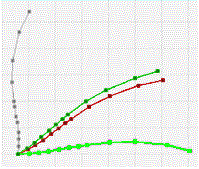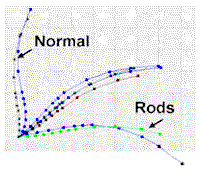|
|
|
|
|

Gross trunk motion was one aspect that was examined. The two middle curves show the trunk position at the halfway point of flexion and recovery from flexion. Note that, despite having Harrington rods implanted from T12 to the sacrum, the patient has a large range of motion. |

To better appreciate how good the gross motion is, his data was compared to that of an age and sex matched normal individual. The surgery patient can barely be discriminated from normal on the basis of trunk range of motion. However, the quality of the motion is different. It is evident that the surgery patient has a very stiff spine. Virtually all the trunk movement is due to rotation about the pelvis. |
|
This is further demonstrated when the lumbosacral angle is plotted versus the trunk flexion angle. In the normal, the spinal curvature (lordosis) decreases as the trunk is flexed. The surgery patient has no variation in lordosis, revealing a very stiff lumbar spine. |
The surgery was successful in restoring gross function to this patient. His overall range of motion is near normal. However, due to the presence of the stabilizing rods, the manner in which the motion is performed is significantly altered.
The next two sections are more technical and are geared to the healthcare professional.
|
|
I Home I
I Contact Us I
I Feedback I
I Search I
|